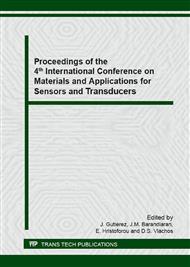[1]
A.K. Geim: Science Vol. 324 (2009), p.1530.
Google Scholar
[2]
K.I. Bolotin, K.J. Sikes and et al.: Solid State Communications Vol. 146 (2008), p.351.
Google Scholar
[3]
H. Hosseinzadega1, C. Todd, A. Lal, M. Pandey, M. Levendorf and J. Park: Graphene has ultra high piezoresistivity gauge factor (IEEE, MEMS, France 2012, p.611).
DOI: 10.1109/memsys.2012.6170262
Google Scholar
[4]
X. Li, W. Cai, J. An, S. Kim, J. Nah, D. Yang and et al.: Science Vol. 324 (2009), p.1312.
Google Scholar
[5]
Q. Yu, J. Lian, S. Siriponglert, H. Li, Y.P. Chen and S.S. Pei: Applied Physics Letters Vol. 93 (2008), p.103.
Google Scholar
[6]
W.S. Hummers Jr and R.E. Offeman: Journal of the American Chemical Society Vol. 80 (1958), p.1339.
Google Scholar
[7]
J. Zhao, S. Pei, W. Ren, L. Gao and H. M. Cheng: Acs Nano Vol. 4 (2010), p.5245.
Google Scholar
[8]
S. Stankovich, D.A. Dikin, R.D. Piner, K.A. Kohlhaas, A. Kleinhammes, Y. Jia and et al.: Carbon Vol. 45 (2007), p.1558.
DOI: 10.1016/j.carbon.2007.02.034
Google Scholar
[9]
H.W. Chang, Y.C. Tsai, C.W. Cheng, C.Y. Lin and P.H. Wu: Electrochemistry Communications Vol. 23 (2012), p.37.
Google Scholar
[10]
K.S. Kim, Y. Zhao, H. Jang, S.Y. Lee, J.M. Kim, K.S. Kim and et al.: Nature Vol. 457 (2009), p.706.
Google Scholar
[11]
C. Lee and et al.: Science Vol. 321 (2008), p.385.
Google Scholar
[12]
K.S. Kim, Y. Zhao, H. Jang, S.Y. Lee, J.M. Kim, K.S. Kim, J.H. Ahn, P. Kim, J.Y. Choi and B.H. Hong: Nature Vol. 457 (2009), p.706.
Google Scholar
[13]
D. Teweldebrhan and A.A. Balandin: Applied Physics Letters Vol. 94 (2009), id. 013101.
Google Scholar
[14]
M. Huang and J.R. Greer: ECS Transactions Vol. 35 (2011), p.211.
Google Scholar
[15]
Y. Kim and et al.: Current Applied Physics Vol. 11 (2010), p. S350.
Google Scholar
[16]
Y. Lee, S. Bae, H. Jang, S. Jang, S.E. Zhu, S.H. Sim and et al.: Nano letters Vol. 10 (2010), p.490.
Google Scholar
[17]
X. Zheng, X. Chen, J. -K. Kim, D. -W. Lee and X. Li: Journal of Micro/Nanolithography MEMS and MOEMS Vol. 12 (2013), id. 013009.
DOI: 10.1117/1.jmm.12.1.013009
Google Scholar
[18]
X.W. Fu, Z.M. Liao, J.X. Zhou, Y.B. Zhou, H.C. Wu, R. Zhang and et al.: Applied Physics Letters Vol. 99 (2011), id. 213107.
Google Scholar
[19]
Gamil et al.: Key Engineering Materials Vol. 605 (2014), p.207.
Google Scholar
[20]
V. Strong, S. Dubin, M.F. El-Kady, A. Lech, Y. Wang, B.H. Weiller and et al.: Acs Nano Vol. 6 (2012), p.1395.
Google Scholar
[21]
M. Pimenta, G. Dresselhaus, M.S. Dresselhaus, L. Cancado, A. Jorio and R. Saito: Physical Chemistry Chemical Physics Vol. 9 (2007), p.1276.
Google Scholar
[22]
Z. Ni, Y. Wang, T. Yu and Z. Shen: Nano Research Vol. 1 (2008), p.273.
Google Scholar


